#enguri dam
Explore tagged Tumblr posts
Text

Enguri dam, Georgia
0 notes
Text
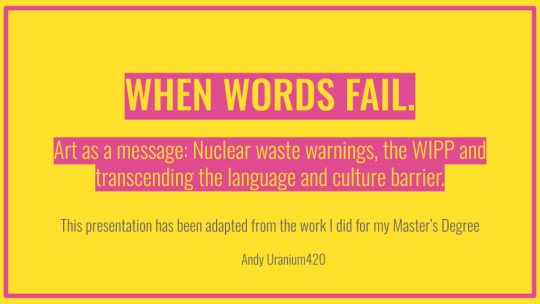
Hello! I wrote this symposium presentation for my master's degree in artistic practise in 2022 :) If you would like to cite this symposium please message me off-anon and I will give you the details needed :)
I considered adapting this presentation into essay format for tumblr, however that would be a massive effort, given that all my sources for this presentation are not formatted for the essay structure.
This is NOT a quick read, but I appreciate you even considering reading :) thank you!
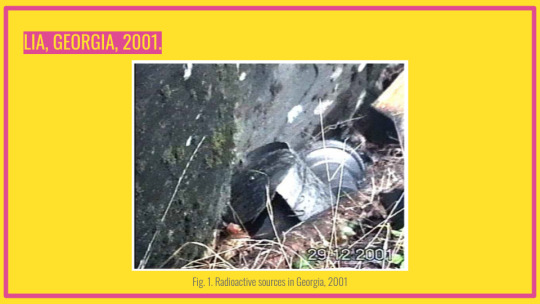
It’s 2nd December 2001, near the Enguri Dam, Georgia. Three men walk into a nearby forest, looking for firewood. The winter sun sets early so the men decide to spend the night in the forest and take the wood back to their trucks the next morning. Around 6pm they find two strange objects, cylindrical in shape, and 15 cm in length. The snow around these objects is melted, and the wet soil is steaming from the heat. One of the men picks up one of the objects, and drops it immediately, as it is too hot to hold. They decide to use the objects as personal heaters, while they sleep in the forest waiting for daylight. They begin to feel sick; so sick they don’t sleep, and spend all night vomiting. The next morning they only load half the firewood into their truck, they are exhausted.
It’s 22nd December 2001. All three men are admitted to hospital. On 23rd January 2002, one of the men is discharged from hospital. On 18th March 2003, a second man is discharged from hospital. On 13th May 2004, the third man dies, having never been well enough to leave.
What they found were radioactive sources of Strontium-90, removed from radioisotope thermoelectric generators, which were scrapped and abandoned upon Georgia’s independence from the Soviet Union, and the termination of the project for which they were to be used. They killed one person, and injured two more. They held no warning signs, marks, or messages.

Art has been used as a form of communication ever since people have been making art. It can transcend current language barriers by virtue of shared cultural ideas and representational imagery, especially in the modern day where we have more access to shared culture and art than ever. Art is hard to define, and there still isn’t a consensus on what it is, however, as journalist Daniel Oberhaus notes, many people know it when they see it. He also notes that cultural context plays an important role in the understanding of art; a urinal is not art, unless it is displayed in a gallery. In The Philosophical Disenfranchisement of Art, Arthur Danto explicitly states that it was a urinal, until it became a work of art- the cultural knowledge of an art gallery changes the meaning of the piece. Niklas Luhmann in his essay The Medium of Art explores the idea that works of art exist to communicate meaning before anything else; that they are produced of a medium, and then become a medium themselves, one of communication. So what do we do, then, when neither consistency of language nor culture is guaranteed? What do we do when art must communicate messages to people so far in the future we cannot make any assumptions about the preconceptions a viewer will bring, or the culture in which they operate? What do we do when the message we have to bring to them is extremely important, and does not leave room for misinterpretation?
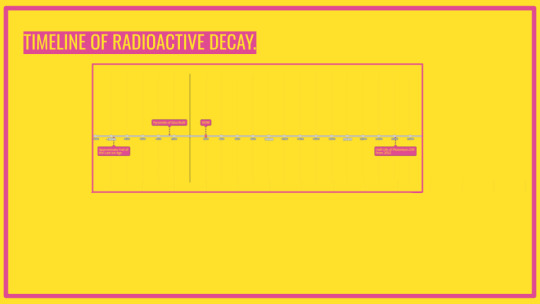
One message that is incredibly important for humans now to send is marking our long term deep geological nuclear waste repositories as dangerous and the areas above them as uninhabitable. However, working with nuclear isotopes, and their long half-lives, confronts us with the aforementioned questions; the message is extremely important, cannot be misinterpreted, and we can safely assume any viewer will share no language or culture with us today.
Most storage involves transuranic elements- that is, isotopes heavier than uranium- used for both creation of nuclear arms, and nuclear power stations, with two of the most common contaminants being Plutonium-329 and Uranium-235. This is the half-life of Plutonium-329.
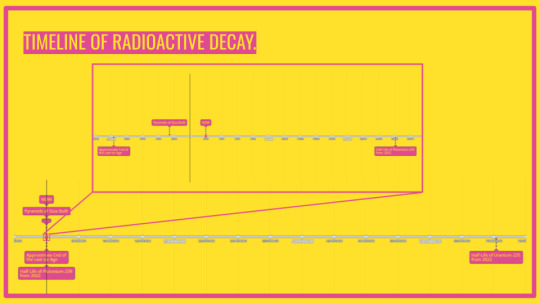
And this is the half-life of Uranium-235.
And this is the time scale on which people have had to think to design warnings for the Waste Isolation Pilot Plant, in New Mexico, USA- licensed to store waste from nuclear arms development which opened for operation in 1999, and is due to be backfilled between 2025 and 2035.
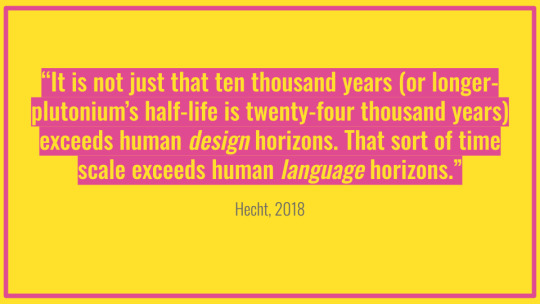
Gabrielle Hecht said of the issue in 2018, “It is not just that ten thousand years exceeds human design horizons. That sort of time scale exceeds human language horizons.��
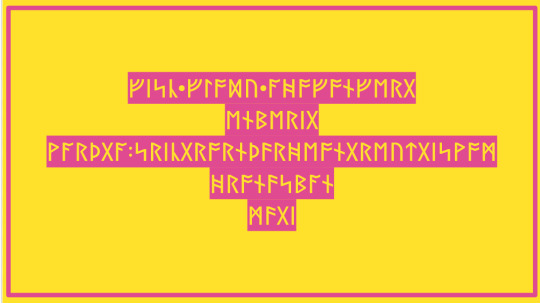
To put a bit of context to these unthinkably large numbers and the issue with communicating over time spans on this scale, this is a fragment of Old English from the Franks Casket, written in Anglo-Saxon runes. This is estimated to have been written only 1,300 years ago. It is unintelligible to English speakers today.
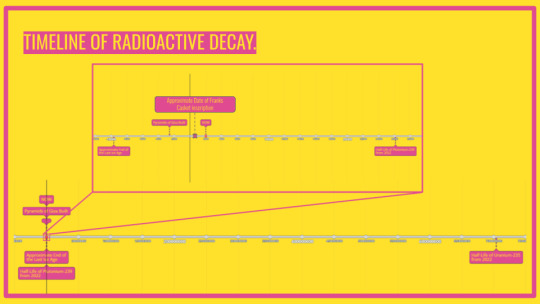
And to put that onto the timeline, we can see the distance in time between the Franks Casket and now is tiny compared to how long the warnings need to last. In his letter declining the invitation to join the Sandia National Laboratories report on nuclear waste markers, Carl Sagan described the problem as such:
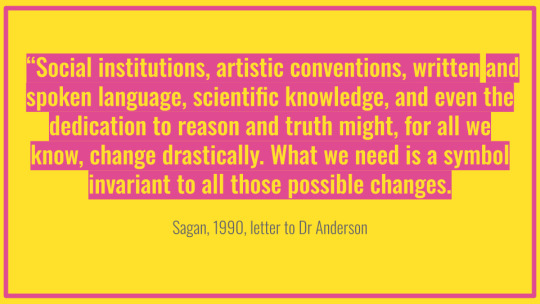
“... artistic conventions, written and spoken language… might, for all we know, change drastically. What we need is a symbol invariant to all those possible changes. Moreover, we want a symbol that will be understandable not just to the most educated and scientifically literate members of the population but to anyone who might come upon this repository.”
Sagan brings up a very important point: the need for any symbol to be universally understood, regardless of the viewer's education, age, or cultural background. This, I think, is the largest obstacle we face, given that we didn’t even have this problem solved until 2007, despite having infinite access to research the people that live now.
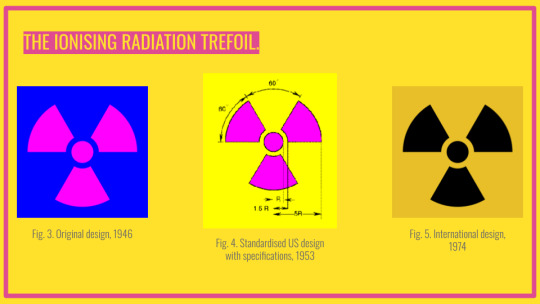
In 2001 the International Atomic Energy Agency and International Organisation for Standardisation were faced with the challenge of making a new symbol to denote immediate severe radiation hazard after a 2000 incident, where three people in Samut Prakan province, in Thailand, died from radiation exposure after coming across a cobalt-60 source, previously used for cancer radiotherapy, in a scrap yard. The source was secured properly (although not disposed of properly), and displayed the proper warning symbols, but it made no difference, because the people didn’t recognise the symbol, and none of the written warnings were in Thai.
The original warning design was conceived at the University of California Berkeley Radiation Laboratory in 1946, by a group of people who were doodling out designs that could be used to symbolically represent radiation hazards. Nels Garden, one of the scientists involved in the designing process, gave insight into the design in letters sent after the event. The design was supposed to represent an atom emitting radiation. The first design was this one, with the magenta trefoil on the blue background. Magenta was chosen because it didn’t conflict with any existing colour coding rules, and the ink was expensive, which they hoped would ensure people did not use the symbol frivolously and reduce its impact as a warning. The blue was chosen because there were no other blue warnings and labels used in radioactive work of the time, meaning it was distinctive, however it received criticism for being low visibility, as well as the fact that blue was not supposed to be used on warning signs, as it fades quickly.
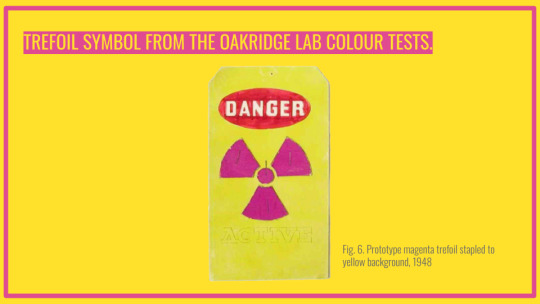
In 1948 yellow was standardised for the sign at the Oakridge National Lab, following requests for a standardised colour scheme, after a committee viewed the magenta symbol stapled to different coloured cardboard, and deemed magenta and yellow the best combination. Until its final standardisation by the American National Standards Institute in the 1950s, there were a few variations of the symbol. In 1974 the ISO approved a design for international use, in which the trefoil is black instead of magenta.
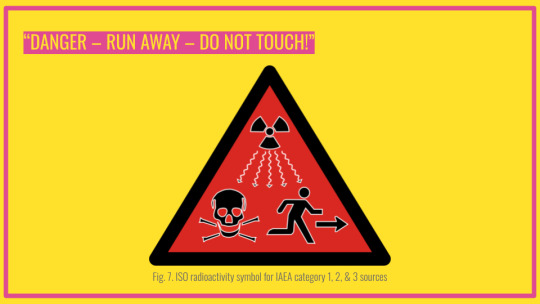
And, in a town in Thailand, none of that mattered. Faced with foreign language warnings and a symbol none of the scrapyard workers recognised, the immediate danger they were in was not adequately communicated by the trefoil. The 2001 assignment, the New Warning Symbols Project, needed a symbol that would unfailingly communicate “danger, run away, do not touch.” In 2007 they presented the high level sealed-source ionising radiation symbol. In target groups of children of many nationalities, the trefoil symbol meant something like a propeller or a windmill, and the colour yellow did not indicate the immediate life threatening danger. In many more tests conducted around the globe, they settled on the current design as being the one that most clearly portrayed the message without words. Of all the symbols tested, skull and crossbones was the only one that consistently conveyed the meaning of “this may harm you so much that you will die.” The yellow was replaced with red to move the warning from “caution” to “active danger” in the eyes of viewers.
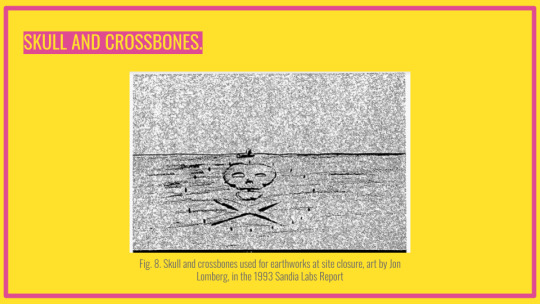
The result of the research echoes what Sagan wrote in his letter to Sandia Labs, recommending skull and crossbones as symbols to be placed around the WIPP, which he said has “unmistakable” meaning, referring to pirate flags, bottles of poison, and Nazi divisions- all things which are bad and to be avoided; although the report itself points out that in Mexico bones are considered to hold life force, so alternative messages would also be required, especially considering the WIPPs proximity to the US-Mexico border, and Oberhaus points out that it only emerged as a symbol of toxicity relatively recently, that is- recently on the scale of radioactive isotopes, with no guarantee it will last.
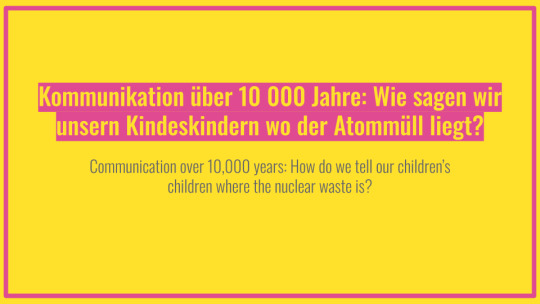
The first published attempt to solve the problem of producing a universally understood message that is as clear in 100 years as it is in 10,000, though posed as a thought experiment rather than as part of government action like the at the time recently formed Human Interference Task Force, was the 1982/1983 poll in the Berlin Institute of Technology’s Journal of Semiotics, which asked “How do we tell our children’s children where the nuclear waste is?”
The suggestions with the least amount of subsequent research (or, at least, subsequent research in English) are, with one exception, the most conceptually mundane, so I will only give an overview of the exciting one. Polish science fiction writer Stanislaw Lem suggested satellites that endlessly transmit the messages back to Earth. He also proposed encoding messages into the DNA of plants that he dubbed Atomic Flowers which would replicate and renew into forever. He suggested that the plants be only grown in the vicinity of the repositories, and contain information about the danger of the camp. The major issue with this, pointed out by Lem himself, was who would ever even think to decode DNA for a hidden message? And if the message was known about would they consider the decoding an endeavour worth pursuing.
Two of the suggestions connected to this poll are more fleshed out, the Ray Cat Solution and the Atomic Priesthood.
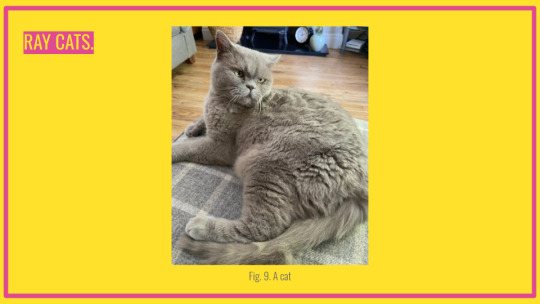
The Ray Cats solution is my personal favourite, in theory. In reality it's wholly problematic, for ethical reasons.
Ray Cats proposes genetically engineering cats to change colour in the presence of radiation, and the message will be passed down and preserved via fairy tales, poems, and nursery rhymes- which are typically long lived and cross-culturally intelligible. It hopes to build off the superstition surrounding black cats- either bad luck or good luck depending on where you are, and your cultural background.
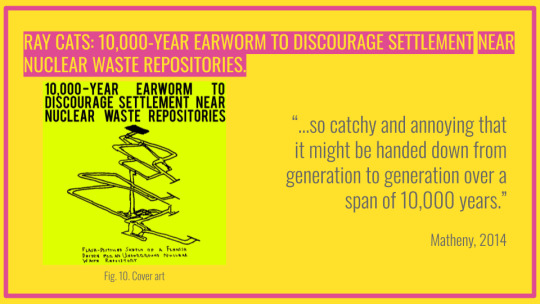
One such cultural marker was a song written 2014 by physicist turned musician Chad Matheny, also known as Emperor X, who described the brief as to create a song “so catchy and annoying it might be handed down… over a span of 10,000 years.” It was titled “10,000-Year Earworm to Discourage Settlement Near Nuclear Waste Repositories”
Beyond the song, there isn’t much art here. There’s a lot of science, and a lot of ethics, but little has been considered artistically.
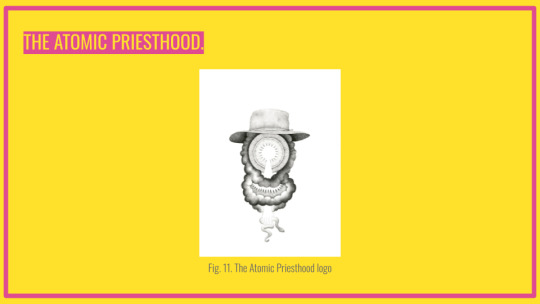
The concept from this poll which has been expanded upon the most is the Atomic Priesthood, suggested by linguist Thomas Sebeok, and it is currently being developed by the Atomic Priesthood Project- a collective of artists working towards preserving the messages of the dangers of nuclear waste and their locations. The Atomic Priesthood is built from the principle that the Catholic Church has survived with a pretty consistent message for 2000 years, and had to convene groups to enact significant change in their doctrine. For example, they would create rituals and myths surrounding the consequences of disturbing the waste. They would dictate which areas are forbidden, and dictate what retribution awaits those who disobey, literal or metaphysical. Issues with this idea arose almost immediately, for example schisms akin to the Protestant Reformation distorting the message, and what happens if Nuclear Atheists emerge, denying the existence of the danger?
Despite the issues, a lot of lore, doctrine, and rite has been established for the Atomic Priesthood. They have worked in collaboration with many artists across many disciplines, including Dana Sherwood, Helen Lee, Duy Hoang, Claire Beaumont and many more.
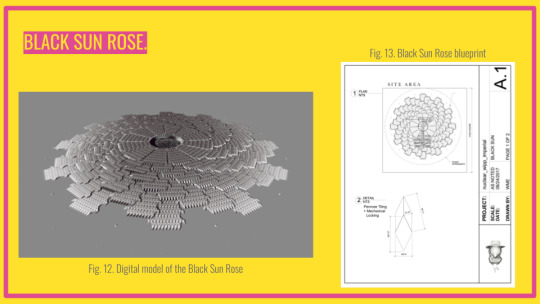
One of their projects, beginning in 2017, was to develop nuclear warning monoliths. They used the WIPP as a base, and followed the guidelines set out in the 1993 Sandia Labs report on Expert Markers to Deter Inadvertent Human Intrusion into the Waste Isolation Pilot Plant, and came up with the Black Sun Rose. They are interlocking monoliths, following a Penrose pattern - meaning they can be tiled infinitely outwards. The blocks are to be cast from black dyed concrete; concrete being readily available and extremely long lasting, and dyed black to discourage animal and human habitation on the site, due to its absorption of New Mexico desert heat. The structure must be at least 4 square miles, large enough to fully cover the underground footprint of the site. At this size, it will also be visible from space.
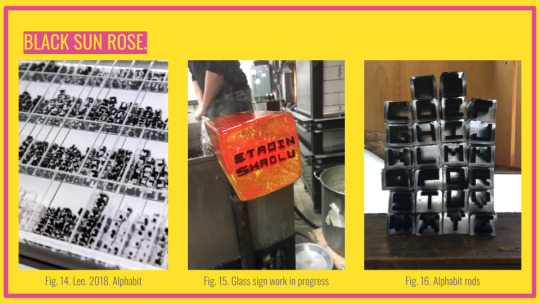
They will also use glass for the embedding of written messages. Glass will be used as it is the most geologically stable and chemically inert material that can be mass produced. The messages will be produced by embedding coloured rods in clear glass, making a sort of 3 dimensional font, based on the work ‘Alphabit’ by Helen Lee. The letters can then be fused into one large wall, with the rods being slightly curved to bounce sunlight through the rods, using the same principle as fibre optic cables. This will cause the walls of text to illuminate. The properties of the glass mean that any writing system or image that can be embedded in this way will not be obscured or removed by damage. This seemingly solves the issue that arises with stone carvings, where chipping of stone can make the message unintelligible.

The rose structure will be perimetered by kiosks, containing the glass panels, and they will warn people to leave, and of the danger, in various languages and through pictograms. There will also be “deep dolmen” and these will be created of the same penrose blocks as the rest of the structure, and be entirely enclosed, with no way of access except removing one of the large blocks- a daunting, but not impossible task, depending on the technological level of the people who find them. The hope is that uncovering something, anything through means of brute force and excavation will be enough of a satisfying result for intruders that the actual danger remains undisturbed. The information stored in these will be much more in depth than what is displayed in the kiosks, but also redundant, such that if they are never opened, the message of the whole site remains intelligible and complete.
As of 2020, these designs are just a proposal.
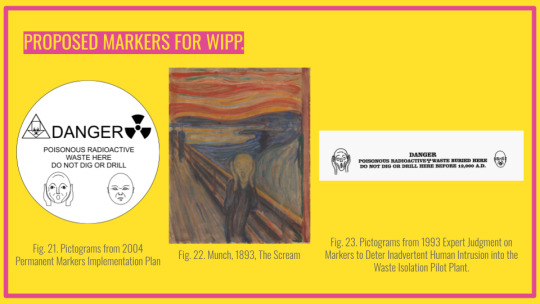
The largest body of research and design concepts comes from the aforementioned 1993 Expert Judgment on Markers to Deter Inadvertent Human Intrusion into the Waste Isolation Pilot Plant produced by Sandia National Laboratory for the United States Department of Energy.
One of the things it covers is the use of pictograms. Working under the assumption that any language spoken today will be gone, they decided that using pictograms along with written warnings would stop the warning signs from becoming entirely obsolete after the extinction of current languages.
The pictograms are more faces and less abstract representations. Usage of Munch’s The Scream was done to portray “abject horror and terror”, and the report concludes that usage of faces is most suitable for cross-cultural intelligibility, as the expressions associated with fear, apprehension, and disgust, are universal. A 2009 study by Matsumo and Willingham analysed the spontaneous expressions produced by congenitally blind, non-congenitally blind, and sighted athletes, and found that there was little difference between the facial emotion configuration between the groups, and no difference at all cross-culturally. So using faces is likely a good call, because unless humans are wiped out and replaced by something else, there shouldn’t be much major change in cultural understanding of expressions, as at least something about them appears to be innate.
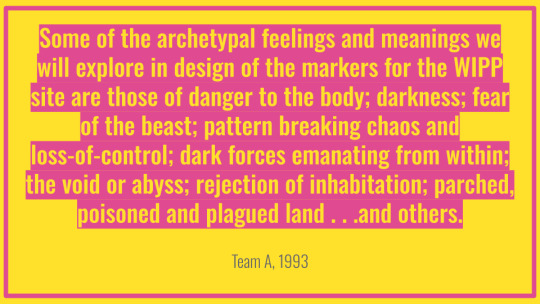
They also considered large structural designs that would go on to inspire the Atomic Priesthood’s Black Sun Rose. As well as emphasising the fact that the structures need to only deny land habitation and produce deep emotional response in the viewer, the report described the designs as provoking feelings of “danger to the body”, “fear of the beast”, “dark forces emanating” and “abyss.”
A 2012 study showed that shapes with sharp abrupt angles are associated with emotions with abrupt onset, such as surprise and anger, and a 2021 study showed, using 3d objects instead of 2d drawings, spiked objects being associated with unpleasant, uncontrolled and high arousal emotions, and we can see this from the designs presented in the report, although no specific research of the kind is mentioned.
The structures are separated into two groups:
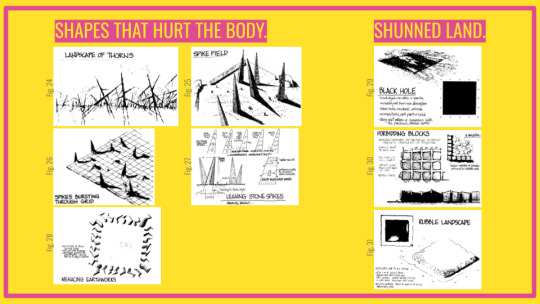
Shapes that hurt the body, and shunned land.
The report describes them as such:
Danger seems to emanate from below. The shapes suggest wounding forms, like thorns and spikes, even lightning. They seem active, in motion cut and up, moving in various directions. They seem not controlled. Walking through it, at ground level, the massive earthworks crowd in on you, dwarfing you, cutting off your sight to the horizon, a loss of connection to any sense of place.
And:
An image of an enormous black hole; an immense nothing; a void; land removed from use with nothing left behind; a useless place. It is a massive effort to make a place that is fearful, ugly, and uncomfortable.
An anomaly both topographic and in roughness of material. An enormous landscape of large-stone rubble, one that is very inhospitable, being hard to walk on and difficult to bring machinery onto. It is a place that feels destroyed, rather than one that has been made. They are deliberately irregular and distorted cubes. The cubic blocks are set in a grid, defining a square, with 5-foot wide’’streets” running both ways. You can get “in” it, but the streets lead nowhere, and they are too narrow to live in, farm in, or even meet in. It is a massive effort to deny use. It is an ordered place, but crude in form, forbidding, and uncomfortable.
None of our designs use any of the regular or “ideal” geometric forms. Why? The geometry of ideal forms, like squares and cubes, circles and spheres, triangles and pyramids is a fundamental human invention, a seeking of perfection in an imperfect world. Historically, people have used these ideal forms in places that embody their aspirations and ideals. In our designs, there is much irregularity both of forms and in their locations and directions, yet done by people with obvious knowledge of pure geometry. This shows an understanding of the ideal, but at the same time a deliberate shunning of it... suggesting we do not value this place, that it is not one that embodies our ideals.
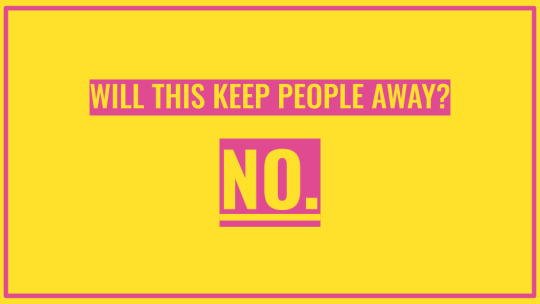
And will any of this work?
No. At least in my opinion.
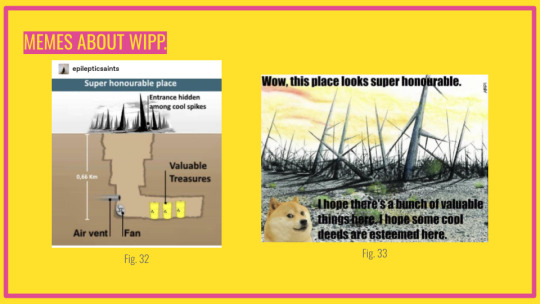
Already the WIPP and its warning messages and structures have become memes; framing the forbidding spires as cool formations that must be there to protect the valuable treasure below.
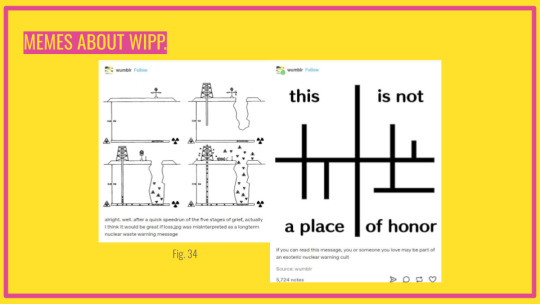
A tumblr user compares an image from the Sandia National Labs report to the meme Loss.jpeg, and jokes that Loss will be interpreted in the future as a nuclear waste warning. And it’s funny, I think it is a funny bit, but underlying a lot of the jokes about these markers is a resignation that we already know none of this will prevent intrusion into the sites.
Physicist Woodruff Sullivan points out in the report that it’s largely a self correcting problem anyway. Nothing is as good a deterrent for disturbing nuclear waste as the consequences of disturbing nuclear waste; but that view requires people to potentially die over and over as each new generation finds the site.
But on the prospect of a more artistic warning, Jon Lomberg succinctly states that:
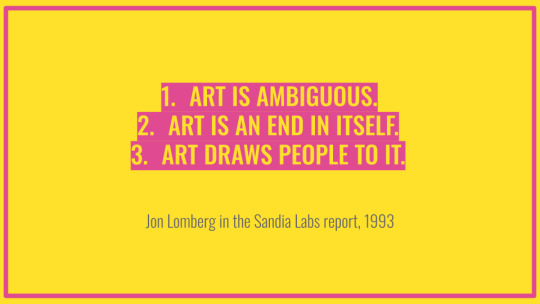
One. Art is ambiguous
Two. Art is an end in itself.
Three. Art draws people to it.
And I am tempted to agree with him.

As “One can hardly imagine a more titillating prospect for archaeologists of the future.”
youtube
And here is the 10,000 year earworm.
List of Figures:
Figure 1. International Atomic Energy Agency (2014) The Radiological Accident in Lia, Georgia. Vienna: International Atomic Energy Agency. pp. 14
Figure 2. Duchamp, M. 1917, replica 1964. Fountain. [Readymade] At: London: Tate Modern. T07573
Figures 3, 5 & 7. Chung, N. (2018) Radiation Symbol (1948) Available at: https://medium.com/fgd1-the-archive/radiation-symbol-1948-fcc2ddc33ff0
Figure 4. Origin of the Radiation Warning Symbol (Trefoil) (no date) Available at: https://www.orau.org/health-physics-museum/articles/radiation-warning-symbol.html
Figure 6. Prototype Trefoil Warning Sign with Yellow Background (1948) (no date). Available at: https://www.orau.org/health-physics-museum/collection/warning-signs/prototype.html
Figure 8. Trauth, K.M., Hora, S.C. and Guzowski, R.V. (1993) ‘Expert judgment on markers to deter inadvertent human intrusion into the Waste Isolation Pilot Plant’, Office of Scientific & Technical Information Technical Reports. pp. G-13
Figure 9. Hargreaves, A. 2022. Literally just a photograph of my cat, Luna. [Photograph]
Figure 10. Matheny, C. (2014) 10,000-Year Earworm to Discourage Settlement Near Nuclear Waste Repositories. Available at: https://emperorx.bandcamp.com/album/10000-year-earworm-to-discourage-settlement-near-nuclear-waste-repositories
Figures 11-13, & 15-20, Black Sun Rose (WIPP) (2017). Available at: http://www.theatomicpriesthoodproject.org/artists#/black-sun-rose-wipp
Figure 14. Lee, H. 2018. Alphabit. [Glass murrine, stainless steel, aluminum, acrylic, LEDs] Available at: https://pink-noise.org/portfolio/alphabit/
Figure 21. United States Department of Energy (2004) Permanent Markers Implementation Plan. Carlsbad: Washington Regulatory and Environmental Services an affiliate of Washington TRU Solutions, LLC. pp. 23
Figure 22. Munch, E. 1893. The Scream. [Oil, tempera, pastel, and crayon] At: Oslo: Nasjonalgalleriet. NG.M.00939
Figure 23. Trauth, K.M., Hora, S.C. and Guzowski, R.V. (1993) Expert judgment on markers to deter inadvertent human intrusion into the Waste Isolation Pilot Plant. Albuquerque: Sandia National Laboratories. pp. F-115
Figures 24-31. Trauth, K.M., Hora, S.C. and Guzowski, R.V. (1993) Expert judgment on markers to deter inadvertent human intrusion into the Waste Isolation Pilot Plant. Albuquerque: Sandia National Laboratories. pp. F-61-F-75
Figure 32. Love How This Implies That After The Downfall Of Humankind That Doge Is The Species To Supercede Us. (2020) Available at: https://parakavka.tumblr.com/post/635856004706418688/
Figure 33. #super honourable place. (2022) Available at: https://epilepticsaints.tumblr.com/post/696755723763367936
Figure 34. alright. well. (2021) https://wumblr.tumblr.com/post/646314177178255360/wumblr-alright-well-after-a-quick-speedrun-of
Bibliography:
Atomsemiotik (no date). Available at: https://www.chemie.de/lexikon/Atomsemiotik.html
Barrett, R. and Stephens, L. D. (1978) A Brief History of a “20th Century Danger Sign.” Berkeley: Lawrence Berkeley National Laboratory. Available at: https://escholarship.org/uc/item/7cz9p0m6#main
Benford, G. (2001) Deep Time: How Humanity Communicates Across Millennia. New York City: Avon Books
Dahlstrom, D. (2007) ‘New Symbol Launched to Warn Public About Radiation Dangers’, International Atomic Energy Agency. Available at: https://www.iaea.org/newscenter/news/new-symbol-launched-warn-public-about-radiation-dangers
Fakultät I Geisteswissenschaften: Bd_6_Hft_3 (no date). Available at: https://www.semiotik.tu-berlin.de/menue/zeitschrift_fuer_semiotik/zs-hefte/bd_6_hft_3/
Griffenhagen, G. and Bogard, M. (1999) History of Drug Containers and Their Labels. Madison: American Institute of the History of Pharmacy.
Hecht, G. (2018) ‘Interscalar Vehicles for an African Anthropocene: On Waste, Temporality, and Violence’, Cultural Anthropology 33, no. 1
Human Interference Task Force (1984) Reducing the Likelihood of Future Human Activities That Could Affect Geologic High-level Waste Repositories. Technical Report. Columbus: Office of Nuclear Waste Isolation. Available at: https://www.osti.gov/servlets/purl/6799619
Ialenti, V. (2020) Deep Time Reckoning: How Future Thinking Can Help Earth Now. Cambridge: The MIT Press.
International Atomic Energy Agency (2002) The Radiological Accident in Samut Prakarn. Vienna: International Atomic Energy Agency. Available at: https://www-pub.iaea.org/mtcd/publications/pdf/pub1124_scr.pdf
International Atomic Energy Agency (2014) The Radiological Accident in Lia, Georgia. Vienna: International Atomic Energy Agency. Available at: https://www-pub.iaea.org/MTCD/Publications/PDF/Pub1660web-81061875.pdf
Jess and Zak (2016) “The Puzzling Meaning and Origin of the Radiation Sign,” University of California Research blog. Available at: https://ucresearch.tumblr.com/post/148796081116/the-puzzling-meaning-and-origin-of-the-radiation
Kawahara, S., and Shinohara, K. (2012). A tripartite trans-modal relationship among sounds, shapes and emotions: A case of abrupt modulation. Proceedings of the Annual Meeting of the Cognitive Science Society, 34, pp. 569-574. Available at: https://escholarship.org/uc/item/47b452vw
Lin, A. et al. (2021) “Feeling Colours: Crossmodal Correspondences Between Tangible 3D Objects, Colours and Emotions,” Proceedings of the 2021 CHI Conference on Human Factors in Computing Systems. Available at: https://doi.org/10.1145/3411764.3445373
Lodding, L. (2007) ‘Drop It and Run! New Symbol Warns of Radiation Dangers and Aims to Save Lives’, International Atomic Energy Agency Bulletin, 48(2), pp. 70-72. Available at: https://www.iaea.org/sites/default/files/publications/magazines/bulletin/bull48-2/48202087072.pdf
Macfarlane, R. (2019) Underland: A Deep Time Journey. London: Penguin Books
MacKenzie, C. (2006) ‘Reducing the Risk from Radioactive Sources’ International Atomic Energy Agency Bulletin, 47(2), pp. 61-63. Available at: https://www.iaea.org/sites/default/files/publications/magazines/bulletin/bull47-2/47202006163.pdf
Matheny, C. (2014) 10,000-Year Earworm to Discourage Settlement Near Nuclear Waste Repositories. Available at: https://emperorx.bandcamp.com/album/10000-year-earworm-to-discourage-settlement-near-nuclear-waste-repositories
Matsumoto, D. and Willingham, B. (2009) “Spontaneous facial expressions of emotion of congenitally and noncongenitally blind individuals.,” Journal of Personality and Social Psychology, 96(1), pp. 1–10. Available at: https://doi.org/10.1037/a0014037
Oberhaus, D. (2019) Extraterrestrial Languages. Cambridge: The MIT Press.
Origin of the Radiation Warning Symbol (Trefoil) (no date). Available at: https://www.orau.org/health-physics-museum/articles/radiation-warning-symbol.html
The Franks Casket/The Auzon Casket. ca. 700. [Whalebone] At: London: British Museum, Britain, Europe and Prehistory. 1867,0120.1
Trauth, K.M., Hora, S.C. and Guzowski, R.V. (1993) Expert judgment on markers to deter inadvertent human intrusion into the Waste Isolation Pilot Plant. Albuquerque: Sandia National Laboratories. Available at: https://doi.org/10.2172/10117359
United States Department of Energy (2004) Permanent Markers Implementation Plan. Carlsbad: Washington Regulatory and Environmental Services an affiliate of Washington TRU Solutions, LLC. Available at: https://www.wipp.energy.gov/library/permanentmarkersimplementationplan.pdf
United States Department of Energy (2018) Site Markers. Available at: https://wipp.energy.gov/pdfs/site_markers.pdf
12 notes
·
View notes
Link
This is a private six day(five nights) tour to Svaneti region with flights from and back to Tbilisi. The tour includes two hikes - one in Becho gorge to see Ushba waterfalls and one to see Chalaadi glacier. Trails are very well marked and the driver will be waiting for the guests while they are hiking.Throughout the tour driver is included however the guide is not included and upon request guiding service can easily be organised. Also the tour includes trip to beautiful village of Ushguli with views on Shkhara mountain range as well as horse riding trip to Qoruldi lakes - upon request the means of transportation can change to a car if guests are not keen to ride horses. Transfers to and from the airports are included as well as Hotel Old house in Mestia or equivalent with dinner & breakfast. Location of the hotel Old House is very good - it is located #Tours2Go #ToursToGo
#4WDTours#ArchitectureTours#BusTours#CarTours#HistoricalTours#MultidayTours#PrivateSightseeingTours#Trending
0 notes
Text
Day 15, Kataisi, 23rd May
Today we had a long drive to get out of the mountains and into new territory. We had to retrace our steps through places we have been before. We had lunch at Zugdidi where we had stayed a few night ago and to be quick most of us opted for McDonalds. Never great. We have been eating mostly Georgian food which has been good. It’s a lot of vegetables, salads and meat. Cheese bread features heavily as well. We have been to some nice restaurants over the trip. From Zugdidi we headed to the Black Sea just to say we had seen it and then onto Katsiai where we had stayed before. A friend mentioned how bleak Georgia looks which it is when you are high in the mountains but overall Georgia is a very green, tree covered country. Most towns have beautiful parks full of massive trees. The autumn colours would be amazing.

No matter where we have driven there are always animals just wandering around. These were horses but a big hog wandered across further along and there are always lots of cows and dogs on or beside the roads. There are many dogs that just roam the streets. They are tagged and people look after them with food etc but they are basically homeless. They are very friendly and no problem anywhere except when they lay in the middle of the road.

The quality of the road was better than yesterday but still left a lot to desire. Our poor bus driver does such a good job in trying to miss as many pots holes as possible and slows down over bumps to spare us as the ride can be very bumpy in parts. I missed taking photos of the worst parts.

There are a few short tunnels along the way.
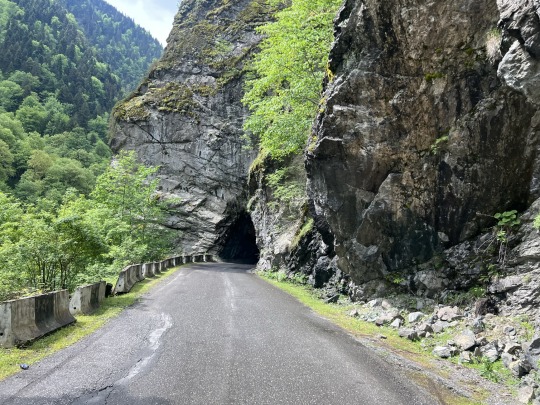
The Enguri River has been dammed and the drive follows the river. This was the upper reaches of the dam.

Lots of potholes and a dog just casually sitting 8n the middle of the road.
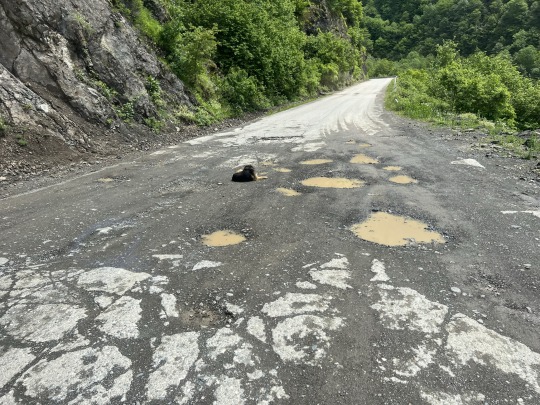
We had stopped at the Enguri Dam on our way up to Mestia but it was completely covered in fog. This time the weather was clear. The dam is the seventh largest dam in the world and the fifth largest concrete arch dam. Planning for the dam started in the 60’s and was completed in 1978. It was quite an achievement to build a hydro electric power station in an active seismic region. The power station provides 46% of Georgia’s power needs. All the timber that washes down to the dam wall is collected and taken back up the mountain to use for heating. In about 6 weeks when more snow melts the dam’s water level will rise considerably.
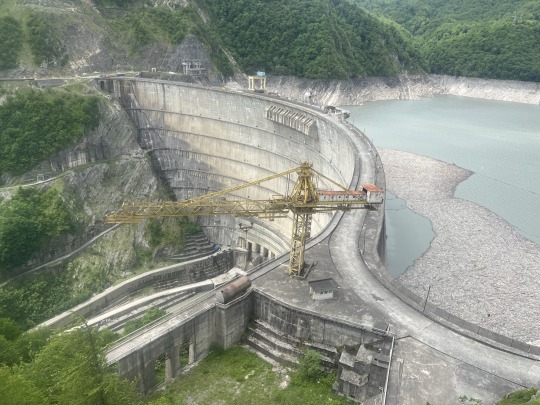
The top biggest dams are found in China.

This is the Black Sea and our wonderful Georgian guide, Davit. He has been great to travel with, so accomodating, interesting and good company. Davit has certainly helped make the trip so memorable. We have now touched the Caspian Sea at Baku in the east and now the Black Sea in the west of this land area.

Paddling in the black sand.

We are back in Kataisi were we had stayed before.
0 notes
Photo

Tama na na granicy z Abhazją. #3dtrip #3dpress #trip #travel #travelblogger #travelphotography #travelgram #summer #oloontour #georgia #gruzja #holiday #wakacje #kaukaz #caucasus #swanetia #enguri #enguridam #dam #lake (w: Enguri Dam) https://www.instagram.com/p/CS68C9JIPPl/?utm_medium=tumblr
#3dtrip#3dpress#trip#travel#travelblogger#travelphotography#travelgram#summer#oloontour#georgia#gruzja#holiday#wakacje#kaukaz#caucasus#swanetia#enguri#enguridam#dam#lake
0 notes
Text
SCC hosts engineers from Georgia’s Enguri Dam, seeks to bridge knowledge between countries - Thu, 19 Apr 2018 PST
One of the world’s tallest hydroelectric dams is in the country of Georgia, a former Soviet state on the Black Sea. SCC hosts engineers from Georgia’s Enguri Dam, seeks to bridge knowledge between countries - Thu, 19 Apr 2018 PST
0 notes
Photo

Enguri Dam, Georgia. Built between 1961-1978. Contribuitor @abetiashvili #_ba_cu . . Map location: http://socheritage.com/ . . Add new sites: http://socheritage.com/add-locations-visitors/ . . Use the #SocialistModernism tag for the possibility to have your #SocHeritage shots featured. All information thus collected will be published on our website. https://www.instagram.com/p/BtvVrCaIVSX/?utm_source=ig_tumblr_share&igshid=eeweuujjkmi8
20 notes
·
View notes
Text


Two Famous Dams: Enguri Dam (Built 1961-1978) in Georgia (Asia); and Ross Dam (Built 1937-1949) in Washington State, U.S.A. - Photos © Engineering Discoveries https://www.kellygrant.ca/Washington.ubr
1 note
·
View note
Photo

Маленький, красивый водопад около Ингур ГЭС (at Enguri Dam) https://www.instagram.com/p/B7sdoMHJ02X/?igshid=n4de3g42k3hl
0 notes
Photo

👻 (at Enguri Dam) https://www.instagram.com/p/B2yzh0BgY9T/?igshid=18469c21lqgtk
0 notes
Photo

ულამაზესი ხედი ენგურის წყალაცავი 💙 სამეგრელო 💙 გზად სვანეთისკენ 💙💙💙 Beautiful view of Enguri Reservoir 💙 Samegrelo💙On the way to Svaneti 💙💙💙 #enguridam #aadpakvis (bij Enguri Dam ენგურჰესი) https://www.instagram.com/p/B2ZjARyIRmo/?igshid=h80gw8ewj8w1
0 notes
Photo

Travel Diaries: Georgia, Day 4 - On the way to Svaneti. As mentioned in the previous post, I became very keen on exploring the Svaneti region for its well-known gorgeous landscape. After leaving Kutaisi I went for a quick stop in Zugdidi and watched the sunset over the Black Sea (I showed it in my Stories and I’ll publish it in my feed soon) then visited an old lady to learn how to make Imeretian Kachapuri from scratch. All amazing experiences but what I really wanted was to reach Svaneti ASAP!
After you leave Zugdidi there’s really only one road to reach Svaneti. It passes by the Enguri dam - the second or third largest dam in the world which was set to become a huge tourist attraction before the development stopped (I rarely talk politics here, but Georgia is badly in need of help from the Western World to resist threats coming from very very close which are corrupting the country) - and then climbs up the mountain region. And you know what’s common in mountain regions: waterfalls 💙!
This one is right in next to the road, and being the snow-melting period even a small river becomes quite powerful, which makes for nice long exposure shots.
Again, I stopped a few times to several other nice scenes, even to cross a fairly scary suspended bridge, but I managed to finally reach Svaneti. And you’ll be able to see it VERY SOON! 🤗 • • #georgia #georgian #georgiatravelmoments #exploregeorgia #svaneti #waterfall #longexposure #longexposure_shots #slowshutter #landscapes #landscape_lovers #landscapelovers #mountainlife #traveldiaries #mytravelgram #travelphotography #outdoors #landscapephotography #landscape_captures #fujifilmx #myfujifilm #fujifilmx_us #youpic #snt (at Samegrelo-Zemo Svaneti) https://www.instagram.com/p/BzN3OyVAua0/?igshid=1q1fai0888201
#georgia#georgian#georgiatravelmoments#exploregeorgia#svaneti#waterfall#longexposure#longexposure_shots#slowshutter#landscapes#landscape_lovers#landscapelovers#mountainlife#traveldiaries#mytravelgram#travelphotography#outdoors#landscapephotography#landscape_captures#fujifilmx#myfujifilm#fujifilmx_us#youpic#snt
0 notes
Photo

🌾 #enguridam #enguri #waterreservoir #mountains #flowers #grass #summervibes #summer2017 #beautifulview #thereisnothingbetterthanmountains (at Enguri Dam)
#mountains#summer2017#beautifulview#flowers#enguri#grass#waterreservoir#summervibes#thereisnothingbetterthanmountains#enguridam
0 notes


